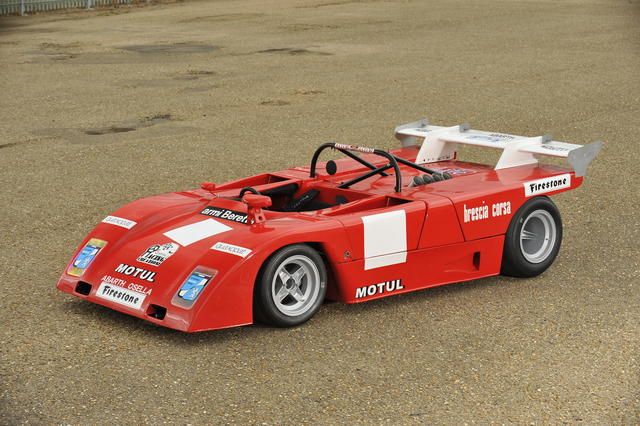1972 Sports Prototype

The descriptions of the Classic Cars in the Directory were partly generated or supplemented with the help of artificial intelligence (AI). The content may occasionally not always be entirely accurate or factually correct despite careful checking.
The Abarth-Osella Sports Prototype 1972 was one of the most acclaimed vehicles of its time, featuring an exceptional design and an array of technical features that set it apart from the pack. This machine was built by Carlo Abarth and his team in collaboration with designer Giuseppe Ostella and was instrumental in establishing the brand's reputation for quality and innovation.
One of the most striking aspects of the Abarth-Osella Sports Prototype 1972 is its aerodynamic design, which was optimized for reduced air resistance and improved handling. The vehicle's sleek, low-slung body was constructed from lightweight materials and featured a number of advanced features, such as a prominent front splitter and a large, adjustable rear wing for increased downforce.
Under the hood, the Abarth-Osella Sports Prototype 1972 was powered by a potent 2.0-liter 4-cylinder engine that was capable of producing up to 210 horsepower (156 kW) at 8,200 rpm. This engine was paired with a reliable 5-speed manual transmission, allowing for snappy gear changes and exceptional acceleration. The vehicle's suspension system consisted of double wishbones at the front and rear, with coil springs and adjustable dampers for improved stability and handling.
Other notable technical features of the Abarth-Osella Sports Prototype 1972 include a highly responsive hydraulic brake system, lightweight magnesium alloy wheels with high-performance tires, and a comprehensive instrumentation package complete with a rev counter, oil pressure gauge, and water temperature gauge. The vehicle also boasted an advanced cooling system with a large frontal radiator and two side-mounted units, along with a highly efficient fuel injection system that contributed to its impressive performance on the track.
Overall, the Abarth-Osella Sports Prototype 1972 was a groundbreaking vehicle that pushed the limits of automotive engineering and design. With its advanced aerodynamics, powerful engine, and exceptional handling capabilities, it was a key player in the world of sports car racing and remains a highly sought-after vehicle among collectors and enthusiasts.
Milestones
- In 1972, Abarth and Osella joined forces to produce the Abarth-Osella sports prototype. - The car featured a mid-mounted, 2-liter, 4-cylinder engine capable of producing up to 250 horsepower. - The chassis was constructed from aluminum and featured a traditional steel-tube space frame. - The car was highly aerodynamic, with features such as a low-slung nose, sloping front fenders, and a rear wing for added downforce. - The Abarth-Osella made its debut at the 500km of Imola, where it finished 5th overall. - It went on to compete in various endurance and hill climb events throughout the 1972 season, including the Targa Florio and the 24 Hours of Le Mans. - The car's best finish of the season came at the 500km of Zeltweg, where it finished 2nd overall. - Despite its relative success, the Abarth-Osella was overshadowed by more dominant prototypes from brands such as Porsche and Matra. - The Abarth-Osella would continue to be developed and raced throughout the early 1970s, with several evolutions and variations of the car being produced.Technical
• Chassis: aluminum monocoque with a steel subframe • Suspension: double wishbone, coil springs, and adjustable shock absorbers • Engine: Fiat DOHC inline-four, 1.6-liter displacement, 190 bhp at 8,800 rpm • Transmission: Hewland five-speed manual gearbox • Brakes: ventilated discs all around, adjustable brake bias • Wheels: 13-inch Borrani alloys • Tires: 6.00-13 front, 7.50-13 rear • Weight: 550 kg (1,213 lbs) • Top speed: 250 km/h (155 mph) • Competed in various endurance racing series and events, including Le Mans, Daytona, and the Targa Florio.